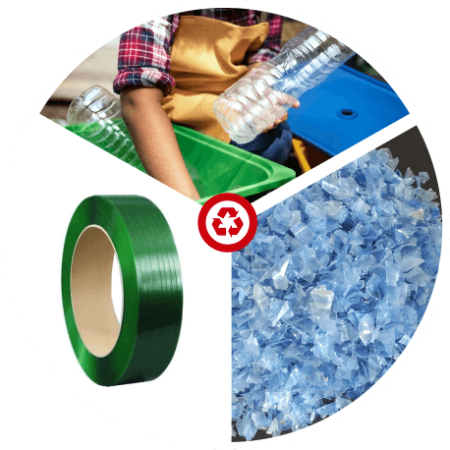Introduction
In today’s world, sustainability has become more than just a buzzword; it’s a guiding principle that shapes the choices we make in manufacturing and packaging industries. As we navigate the complex landscape of environmental responsibility, one solution stands out as a beacon of hope: RPET straps. In this blog post, we will explore the fascinating world of RPET (Recycled Polyethylene Terephthalate) straps and delve into why they are the sustainable choice for the environment.
Understanding RPET (Recycled Polyethylene Terephthalate)
Let’s begin by demystifying RPET. RPET stands for Recycled Polyethylene Terephthalate, a mouthful that represents a powerful sustainability innovation. It is essentially a form of plastic made from recycled PET (Polyethylene Terephthalate) materials, commonly found in products like plastic bottles. The process of transforming PET into RPET involves collecting, cleaning, and processing used PET items, ultimately reducing plastic waste and conserving resources.
RPET straps are a prime example of how recycled materials can be harnessed to create a sustainable alternative for various applications, including packaging and strapping. By embracing RPET straps, companies can play a pivotal role in reducing plastic waste and its detrimental impact on the environment.
The Environmental Impact of Traditional Straps
1. Single-Use Plastic Predicament: Traditional strapping materials, predominantly crafted from single-use plastics, pose significant environmental challenges. These materials are designed for one-time use and are often discarded after fulfilling their primary function. This disability leads to a substantial accumulation of plastic waste, adding to the global plastic pollution crisis.
2. Contribution to Plastic Pollution: The disposal of single-use plastic straps contributes significantly to the proliferation of plastic waste in landfills and oceans. These straps are not easily biodegradable, and their persistence in the environment harms ecosystems and endangers wildlife.
3. Carbon Footprint of Virgin Plastics: The production of traditional strapping materials, which primarily rely on virgin plastics, exacts a considerable carbon footprint. The extraction and manufacturing processes involved in creating virgin plastics are energy-intensive, leading to increased greenhouse gas emissions. This exacerbates the ongoing climate change issues and contributes to environmental degradation.
4. Energy-Intensive Extraction: Virgin plastics are derived from the extraction of fossil fuels, a process that demands substantial energy resources. This energy-intensive extraction depletes non-renewable resources and places additional strain on the environment.
5. Greenhouse Gas Emissions: The manufacturing of virgin plastics involves multiple stages, each of which consumes energy and releases greenhouse gases into the atmosphere. These emissions, primarily in the form of carbon dioxide (CO2), contribute to the greenhouse effect, trapping heat and driving global temperature rise.
6. Non-Sustainable Production: The production of traditional strapping materials from virgin plastics follows a linear, non-sustainable model. This linear model involves extracting, manufacturing, using, and disposing of plastic materials without incorporating recycling or circular economy principles.
In summary, traditional strapping materials made from single-use plastics pose a dual threat to the environment. They not only contribute to the global plastic pollution crisis by creating non-recyclable waste but also exacerbate climate change through the energy-intensive processes involved in their production. Recognizing these environmental challenges underscores the need for sustainable alternatives, such as RPET straps, that mitigate these adverse impacts while providing practical and eco-conscious strapping solutions.
Benefits of RPET Straps
Now, let’s explore why RPET straps are gaining recognition as a sustainable choice for the environment:
Environmental Benefits:
-
Reduced Plastic Waste: RPET straps are a prime example of the circular economy in action. They divert used PET items from landfills and recycling facilities, extending their lifecycle and reducing the overall volume of plastic waste.
-
Lower Carbon Footprint: The production of RPET straps requires less energy compared to virgin plastic materials. This results in a lower carbon footprint, contributing to overall environmental conservation efforts.
Economic Benefits:
-
Cost-Effectiveness: RPET straps offer a cost-effective alternative to traditional strapping materials, making them an attractive option for businesses looking to reduce costs while being environmentally responsible.
-
Resource Conservation: By utilizing recycled materials, RPET straps reduce the demand for new plastics, conserving valuable resources and contributing to a more sustainable future.
Performance Benefits:
-
Durability and Strength: RPET straps are known for their durability and strength, making them suitable for various applications, from securing heavy cargo in transportation to bundling products in warehouses.
-
Versatility in Applications: RPET straps can be used across a wide range of industries and applications, making them a versatile choice for businesses seeking sustainable strapping solutions.
RPET Straps in Various Industries
-
RPET straps, crafted from Recycled Polyethylene Terephthalate, have established themselves as versatile and eco-friendly strapping solutions across a myriad of industries. These sustainable straps have transcended conventional boundaries, finding applications that span diverse sectors, each benefiting from the unique advantages they offer.
-
In the realm of Packaging and Shipping, businesses have embraced RPET straps as a means to secure their products with both security and environmental consciousness in mind. These straps provide a reliable and robust method for bundling packages, ensuring that contents remain intact during transit. Moreover, their eco-friendly nature aligns with the global shift towards reducing plastic waste, making them a preferred choice for sustainable packaging solutions. As businesses opt for RPET straps, they not only fortify their shipments but also reduce their environmental impact.
-
Agriculture and Farming have witnessed the integration of RPET straps in various essential tasks. From bundling crops to supporting vines, these straps provide invaluable assistance in agricultural operations. Their strength and durability ensure that delicate crops are held securely, preventing damage during growth and harvest. In this context, RPET straps not only contribute to the efficiency of farming practices but also align with the eco-conscious mindset of sustainable agriculture.
-
The Construction and Building Materials sector has also recognized the merits of RPET straps. Their robust construction and resistance to wear and tear make them ideal for securing building materials and equipment on bustling construction sites. These straps not only enhance safety by preventing accidents related to unsecured loads but also contribute to cost savings through the extended usability of materials. In this industry, RPET straps are heralded as both a safety measure and a means of optimizing resource utilization.
-
Even the Fashion and Accessories industry has embarked on a sustainable journey, with RPET straps playing a pivotal role in this transformation. Fashion brands and accessory manufacturers have embraced the use of these straps in bags, accessories, and apparel packaging. Beyond their utilitarian function, RPET straps convey a powerful message of sustainability and environmental responsibility. By incorporating RPET straps into their products, fashion companies not only appeal to eco-conscious consumers but also participate in reducing the fashion industry’s ecological footprint.
-
In essence, RPET straps have transcended their conventional roles and are now integral to the operations of diverse industries. Their ability to blend strength, sustainability, and versatility has made them indispensable in sectors ranging from packaging and agriculture to construction and fashion. As these industries continue to prioritize eco-conscious choices, RPET straps stand as a shining example of innovation that benefits both business operations and the planet.
-
With Radhe Plastic Ltd. at the forefront of promoting sustainable choices, RPET straps epitomize a future where responsible materials play a pivotal role in shaping industries for the better.
Recycling RPET Straps
One of the noteworthy aspects of RPET straps is their recyclability. After their useful life, RPET straps can be collected and recycled, completing the sustainability loop. Encouraging responsible disposal and recycling practices is crucial to maximize the environmental benefits of RPET straps.
Future Trends and Innovations
Looking ahead, the future of RPET straps and sustainable strapping solutions appears promising. As companies increasingly prioritize sustainability, the demand for eco-friendly strapping materials like RPET is expected to grow. Emerging trends include advancements in RPET strap technology, such as improved strength and versatility, making them even more appealing for various industries.
Conclusion
In conclusion, RPET straps represent a sustainable choice for the environment, offering a solution that addresses the plastic waste crisis and reduces the carbon footprint associated with traditional strapping materials. By embracing RPET straps, businesses can contribute to a more eco-conscious future while benefiting from cost-effective, durable, and versatile strapping solutions.
At Radhe Plastic Ltd., we take immense pride in advocating for sustainable choices, including the adoption of RPET straps and water hose pipe solutions. Our commitment to delivering high-quality strapping solutions while prioritizing environmental responsibility drives us forward in our mission to create a better, more sustainable world.





